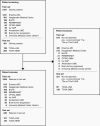Combined molecular subtyping, grading, and segmentation of glioma using multi-task deep learning
- PMID: 35788352
- PMCID: PMC9925710
- DOI: 10.1093/neuonc/noac166
Combined molecular subtyping, grading, and segmentation of glioma using multi-task deep learning
Abstract
Background: Accurate characterization of glioma is crucial for clinical decision making. A delineation of the tumor is also desirable in the initial decision stages but is time-consuming. Previously, deep learning methods have been developed that can either non-invasively predict the genetic or histological features of glioma, or that can automatically delineate the tumor, but not both tasks at the same time. Here, we present our method that can predict the molecular subtype and grade, while simultaneously providing a delineation of the tumor.
Methods: We developed a single multi-task convolutional neural network that uses the full 3D, structural, preoperative MRI scans to predict the IDH mutation status, the 1p/19q co-deletion status, and the grade of a tumor, while simultaneously segmenting the tumor. We trained our method using a patient cohort containing 1508 glioma patients from 16 institutes. We tested our method on an independent dataset of 240 patients from 13 different institutes.
Results: In the independent test set, we achieved an IDH-AUC of 0.90, an 1p/19q co-deletion AUC of 0.85, and a grade AUC of 0.81 (grade II/III/IV). For the tumor delineation, we achieved a mean whole tumor Dice score of 0.84.
Conclusions: We developed a method that non-invasively predicts multiple, clinically relevant features of glioma. Evaluation in an independent dataset shows that the method achieves a high performance and that it generalizes well to the broader clinical population. This first-of-its-kind method opens the door to more generalizable, instead of hyper-specialized, AI methods.
Keywords: deep learning; glioma; multi-task; radiomics; segmentation.
© The Author(s) 2022. Published by Oxford University Press on behalf of the Society for Neuro-Oncology.
Figures




References
-
- Louis DN, Perry A, Reifenberger G, et al. . The 2016 World Health Organization classification of tumors of the central nervous system: a summary. Acta Neuropathol. 2016;131:803–820. - PubMed
-
- Chen C-C, Hsu P-W, Wu T-WE, et al. . Stereotactic brain biopsy: single center retrospective analysis of complications. Clin Neurol Neurosurg. 2009;111:835–839. - PubMed
Publication types
MeSH terms
Substances
LinkOut - more resources
Full Text Sources
Medical

